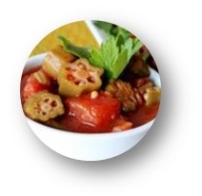 “I freed thousands of slaves. I could have freed thousands more, if they had known they were slaves,” powerful words spoken by the late Harriet Tubman, a conductor of the Underground Railroad, fondly referred to as Black Moses. Just minutes away from me in Anacostia is the home of Frederick Douglass—a former slave and abolitionist—who was visited by Harriet several times bringing African slaves seeking freedom.
“I freed thousands of slaves. I could have freed thousands more, if they had known they were slaves,” powerful words spoken by the late Harriet Tubman, a conductor of the Underground Railroad, fondly referred to as Black Moses. Just minutes away from me in Anacostia is the home of Frederick Douglass—a former slave and abolitionist—who was visited by Harriet several times bringing African slaves seeking freedom.
In many ways the spirit of dear Harriet lies within me as I pursue becoming a registered dietitian. For me food is freedom as I see children eating junk food and their parents’ bodies burdened by excess weight and minds filled with stress. During slavery, soul food was cheap food undesired by the plantation owner providing enough energy to do a day’s work. Making a way out of no way, enslaved African women working and living on plantations, they transformed meager portions into healing meals. The key ingredients were not salt pork and spices but faith, creativity and love.
My path into nutrition began as a young girl growing up in Oklahoma with a desire to heal my mother. Feeling like I failed in pursuing a health professional career, instead I went into public service. Yet after experiencing the sudden loss of my father who shared the love of food and gardening herbs like me; my path came back home to my first love—nutrition.
So far I have been on the journey educating children and families in preschools, child care centers and most of all—at the farmer’s markets in Ward 7 and 8. Recently I recruited an African American dietitian to the diversity recruitment coordinator position within the DC Metro Area Dietetic Association. On campus, my class project addresses increasing underrepresented minorities in the dietetic profession. At St. Teresa of Avila, I am educating parishioners on good nutrition and preparing healthy Sunday meals through the health ministry. In my own way I am making a difference in the field and in my community.
By faith Harriet took people to the Promise Land. And the holy trinity of faith, food and family guides me. The kitchen—today’s promise land—becomes a healing space for families to create meals that heal and not kill themselves or their children. Creating a social climate that encourages family bonds through cooking and eating at home is critical.
However due to limited time, lack of desire to clean and relying on take out and partners to cook, 28% of Americans don’t know how to cook according to a new survey published in the Tufts Health and Nutrition Newsletter. Alice Lichtenstein, DSc, director of Tufts’ HNRCA Cardiovascular Nutrition Laboratory, comments, “The results of this survey highlight what we have known for some time: the importance to incorporating food preparation and purchasing skills into the school curriculum.”
Dietetic professionals are on the frontline of tackling poor lifestyle and bad eating habits. We need more ‘Harriets’ to lead a new path to freeing the minds and bodies from the rising rates of childhood obesity and diet-related diseases such as diabetes, cancer, and hypertension through good nutrition. Raquel Carter, RD who serves as the diversity recruitment coordinator for DCMADA shares that ‘we must also strive to incorporate more cultural diversity within the profession in order to better serve the needs of our clients and patients, especially patients of color.’
According to the 2011 American Dietetic Association (now called the Academy of Nutrition and Dietetics) survey nationally there are 3% African American registered dietitians compared to 83% white; 5% are Asian, Native Hawaiian, or Pacific Islander; and 3% are Hispanic. The lack of diversity is partly due to a lack of awareness, diversity, and training support this gap has occurred as reported by 2008 published in the Journal of the American Dietetic Association.
Not reflective of the Washington, DC’s population is 55.6% black, 36.3% white, 8.3% Hispanic (of any race), 5% other (including Native Americans, Alaskans, Hawaiians, and Pacific Islanders), 3.1% Asian, and 1.6% mixed. Furthermore the greater Washington region has a rising growth of a foreign-born African population (mostly from West and East regions) of 11% of all foreign-born.
It’s been shown that minority health professionals are more likely to serve minority communities. Therefore if we wish to reverse the poor health trends in communities like East of the River, we must train more minorities to pursue careers in nutrition and dietetics.
“There seems to be cultural and racial disparities regarding these issues in that access to nutrition services is not equally available to all individuals,” says Raquel Carter, RD. “I believe that patients of color do wish to see diversity in the dietetic profession.”
The Farmer’s Markets are a place of healing with local and fresh produce. That’s where I provide recipes and tastings infused with African culture while promoting the farmers’ crops. It’s my way of reintroducing the lost African heritage into the African American diet while sharing a passion for good nutrition, because food brings people together.
Like minority medical recruitment initiatives, the dietetics field can develop summer enrichment programs, improve existing mentorship programs, and increase scholarships to attract college students to become registered dietitians especially if medical school doesn’t work. Because an ounce of prevention through good nutrition education by a culturally diverse, compassionate dietetic workforce will save health care costs for the family and the nation.
A culturally diverse team of dietitians becomes valuable especially in knowing different languages. “Diversity makes life easier. You can read all you want but having the real life experience is better in working with patients,” Robin Brannon, MS, RD, CSO, clinical nutrition manager at George Washington University Hospital.
In raising a new crop of registered dietitians, academic programs in dietetics such as the University of the District of Columbia are training students to meet the cultural and international needs of Washington, D.C. Students in the program speak several languages and represent countries like Nigeria, Jamaica, Angola, Argentina, Canada, Vietnam, and France to name a few.
Tsedal Ashby, a junior in the UDC’s nutrition program, stated her “culture adds value” because it’s diverse and gives her the ability to work with people from all walks of life. Also the dietetics field needs additional educational resources to train dietitians to encourage clients to keep their culture intact in the diets while improving their health.
UDC nutrition graduates go on to work for community nutrition programs like WIC and in hospitals with high percentages of minority patients. Dr. B. Michelle Harris, PhD, MPH, RD, an assistant professor of nutrition at UDC shares the program “provides students with the opportunity in the field working diverse clientele through class projects and volunteerism.”
With more ‘Harriets’ in the community, the journey to freedom through good nutrition is possible. Will you support the journey?
Tambra Raye Stevenson, MS is the President of the Student Dietetic Association at the University of the District of Columbia. You can reach her on twitter.com/tambra or at tambra.stevenson@alumni.tufts.edu.















